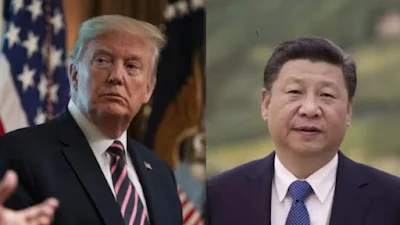Geneva/Washington, May 11, 2025 – The United States and China have reached a tentative trade agreement following two days of high-stakes negotiations in Geneva, marking a potential turning point in a protracted trade conflict that has rattled global markets.
In an announcement on Sunday, the White House confirmed that a deal had been struck. Beijing, in turn, hailed the outcome as an “important first step” in resetting relations between the world’s two largest economies.
U.S. Treasury Secretary Scott Bessent, speaking to reporters after the talks concluded, said there had been “substantial progress” in the negotiations with Chinese Vice Premier He Lifeng, signaling a breakthrough in efforts to defuse the trade war triggered by President Donald Trump’s imposition of 145% tariffs on Chinese imports.
In a televised news conference, He described the discussions as “candid” and confirmed that “substantive progress” had been made toward reaching an “important consensus,” according to Chinese state media. He also noted that a joint statement would be issued on Monday.
While Bessent held back from providing specific details, he noted in remarks posted on the White House’s official social media accounts: “I can tell you that the talks were productive.”
U.S. Trade Representative Jamieson Greer, who appeared alongside Bessent, was more explicit in framing the outcome as a clear agreement. “It’s important to understand how quickly we were able to come to agreement, which reflects that perhaps the differences were not so large as maybe thought,” he said.
Greer also emphasized the origins of the dispute: “Just remember why we’re here in the first place. The United States has a massive $1.2 trillion trade deficit, so the president declared a national emergency and imposed tariffs, and we’re confident that the deal we struck with our Chinese partners will help us to resolve, work toward resolving that national emergency.”
From Beijing, Li Chenggang, China’s international trade representative, said the two sides had agreed to create a joint mechanism focused on “regular and irregular communications related to trade and commercial issues.”
Asked whether a communique would be released before financial markets opened, Li responded with a metaphor: “If the dishes are delicious, timing is not a matter … Whenever released, it is going to be big, good news.”
Markets React to Signs of De-escalation
The Geneva talks marked the first in-person negotiations between Bessent, Greer, and He since tariffs exceeding 100% were imposed by both nations. The resulting trade war has disrupted global supply chains, prompted layoffs, and increased wholesale prices across industries.
Although Bessent has previously stated that tariffs needed to come down as part of any de-escalation, he did not offer details on reductions and declined to take questions from the press.
President Trump, in a Saturday night post on his social media platform, signaled a positive trajectory: “The two sides are working on a total reset … in a friendly, but constructive, manner. Many things discussed, much agreed to. We want to see, for the good of both China and the U.S., an opening up of China to American business. GREAT PROGRESS MADE!!!”
Trump’s rhetoric suggested a fresh approach, though critics noted that his call to “open” China to U.S. business appeared to overlook more than five decades of trade relations since President Richard Nixon’s landmark 1972 visit to Beijing.
U.S. Commerce Secretary Howard Lutnick confirmed in an interview with CNN that a “10% baseline tariff” would remain in place for the foreseeable future, even on imports from countries that finalize new trade agreements with the U.S.
Lutnick also dismissed concerns about domestic job losses linked to the tariffs. “This is just a China problem right now,” he said. “The rest of the world is 10% [tariffs]. So don’t overdo it.” He added: “Prices are going to stay stable once this policy is done.”
Kevin Hassett, Director of the National Economic Council, struck an optimistic tone. “What’s going to happen in all likelihood is that relationships are going to be rebooted. It looks like the Chinese are very very eager to play ball and renormalise things … they really want to rebuild a relationship that’s great for both of us.”
Hassett also highlighted last week’s limited trade agreement between the U.S. and the United Kingdom, calling it a “really exciting blueprint” for future deals. He revealed that 24 trade agreements with other countries are currently in the pipeline: “They all look a little bit like the UK deal but each one is bespoke,” he said.
Cautious Optimism Amid Uncertainty
Despite the upbeat tone from officials, some analysts remain skeptical. Gary Hufbauer, a senior non-resident fellow at the Peterson Institute for International Economics, remarked, “The fact the talks are even happening is good news for business, and for the financial markets.”
However, he warned that “even a tariff rate of 70–80% would still potentially halve bilateral trade,” noting, “I’m very sceptical that there will be any return to something like normal U.S.-China trade relations.”
Wendy Cutler, Vice President of the Asia Society Policy Institute (ASPI), added: “The devil will be in the details. Without the details, it’s hard to assess whether the meeting was successful or not.”
As financial markets await Monday’s joint statement, all eyes remain on Washington and Beijing to see whether this latest breakthrough marks a temporary reprieve—or the beginning of a sustained reset in global trade relations.




.png)
The opinions posted here do not belong to 🔰www.indiansdaily.com. The author is solely responsible for the opinions.
As per the IT policy of the Central Government, insults against an individual, community, religion or country, defamatory and inflammatory remarks, obscene and vulgar language are punishable offenses. Legal action will be taken for such expressions of opinion.